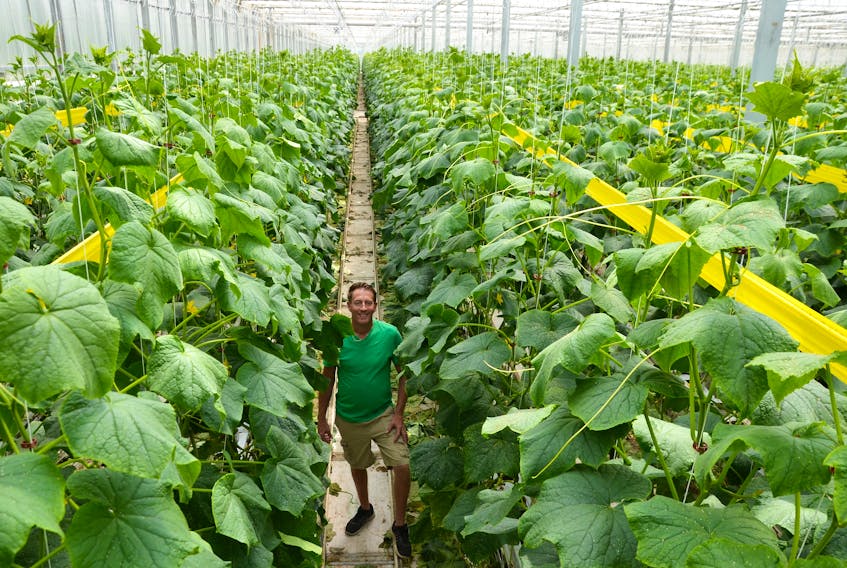LAWRENCETOWN, N.S. - Located right off the Harvest Highway, a huge array of greenhouses can be seen near Lawrencetown. It’s a bit of a change of scenery from the traditional fields, cattle and silos.
Eleven months of the year, those greenhouses are able produce tomatoes and cucumbers, which are then shipped to grocery stores and markets throughout the Maritimes.
It’s local produce, even in the snow.
Luke den Haan is the owner of Den Haan Greenhouses, eight acres of crop-producing glinting glass. He’s planning to expand in the next few years, doubling in size to 16 acres.
“We produce product for 11 months of the year,” den Haan said. “Our product stays 100 per cent in Atlantic Canada.”
Those vegetables — primarily tomatoes and cucumber — make it onto the shelves of Atlantic SuperStores, Sobeys, and several farmers’ markets throughout the Valley, den Haan said.
But this is nothing new. Den Haan Greenhouses have been in operation since 1963, expanding several times since then.
Den Haan also says the company has improved its efficiency over the years, managing 67 kilograms of tomatoes per square metre and 200 cucumbers per square metre.
“We’ve been in business for decades, and have had a couple of different locations, we built a new greenhouse in 1999 and we then added another four acres in 2012,” he said. “We kept hearing ‘we need more, we need more.’ Demand keeps going up. The market for food grown in this way, pesticide free, controlled environment, is growing.”

European example
Den Haan, along with several other farmers from the province and a delegation from the provincial government, attended a trade mission in the Netherlands in early 2018 to see how farmers there are able to produce a large amount of food in innovative ways.
He was amazed that the farmers are able to produce 12 months a year.
“We only harvest 11 months of the year, well, there’s a month there that the cash flow is dry,” he said. “But if we had LED lighting, and have year-round production, we would have no cash flow problems.”
One of the locations they visited was Koppert Cress outside of The Hague. He was incredibly impressed by the technology on display, producing a number of microgreens, usually used in salads.
But, the challenge of moving to this type of agriculture is the cost.
It’s more difficult to rely on what mother nature provides for free when there’s a barrier to the elements, and there’s an increased need for bio-control bugs. Den Haan also needs up to 45 people on staff to keep things up and running.

Heat is another issue. The company goes through two trailer-loads of wood every day to keep its biomass plant firing from November to April, which provides hot water to heat the greenhouses.
“Quality is what sells, and that’s what we need to have a competitive advantage over Mexico or even Ontario,” he said. “The challenge is that 99 per cent of my product needs to be marketable as number ones.”
Along with the eight-acre expansion, den Haan is planning to set up carbon capture from the biomass plant exhaust and re-using that for plant feed.
“We want to become a self-sustaining, carbon neutral unit,” he said. “We also want to install LED lights for year-round production in the years ahead.”
Once the project is complete, there would be 16 acres of crop, all under greenhouse.
But there’s still room for more, den Haan said, saying he wouldn’t be surprised if more greenhouse farms start popping up across the province.
But, it’s not cheap. The cost is $1.2 million per acre, den Haan said.
“The cost is the barrier.”
Province sees opportunity
Keith Colwell, the provincial minister of agriculture, also went on the trade mission in The Netherlands and said the province can learn a lot from farming techniques abroad.
“There’s a number of greenhouses in the province that operate year-round, providing tomatoes, lettuce and more,” Colwell said. “We’re looking at a lot more potential in that area.”
The Netherlands produces more food per square kilometre than any other nation on earth, with high efficiency, thanks largely to greenhouses.
Colwell said the trade mission was a “real eye-opener” both for him and the farmers who went.

“The real problem in the wintertime is the heat source and lighting,” Colwell said. “We looked at all of the different lighting they use, the geothermal heating, some wells are up to 10 kilometres deep, pumping the heat into the earth in the summertime and extracting it in the winter.
“It’s something we don’t really do in Nova Scotia yet, but it’s something we’re looking at now.”
Colwell said there are a broad range of programs and incentives that registered farmers can look into for funding, with the possibility of more on the way to boost innovation and green technology in the sector.
“We are concerned about food security in the province and food supply. The other things we’re concerned about is the fact that we don’t know what’s happened to (imported) food before we get it,” he said.
“In Canada and Nova Scotia, we have very strict rules around food safety, and some of the other countries the food is brought in from don’t necessarily have the same high level of food safety.”
Colwell said the province is always interested in looking into ways to improve efficiency and ensure the environment is well protected, but, it has to make good business sense as well.
“I also told our farmers that I want them to be able to make money too, because if they don’t make money they can’t reinvest and it’s not a sustainable business model,” he said. “We’re willing to look at any program that will help our industry grow, be more sustainable, provide us with a safe food source and also displace imports.”
Colwell said he wouldn’t be surprised if these technologies started popping up across Nova Scotia in the next 10 years, or perhaps even sooner.
“It can be done here, and it can be done very well, there just needs to be a business model that makes sense,” he said. “We’ll definitely work with the industry to make those things happen. In some ways, we’re leading in the world, but in other areas we’re learning from others. This industry is up to the challenge.”









